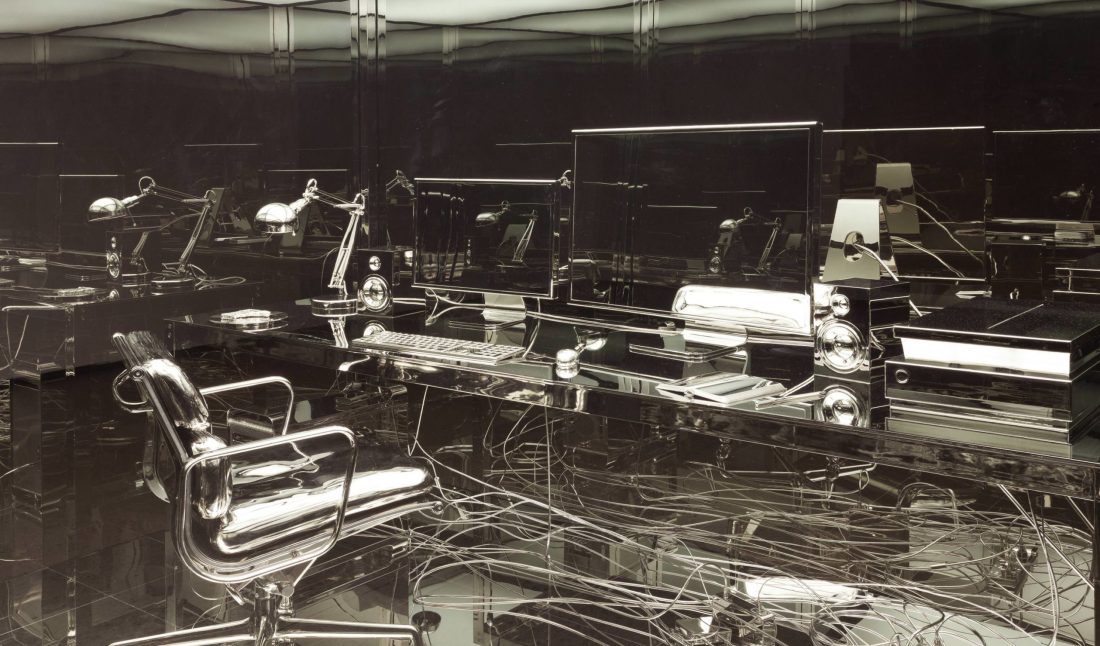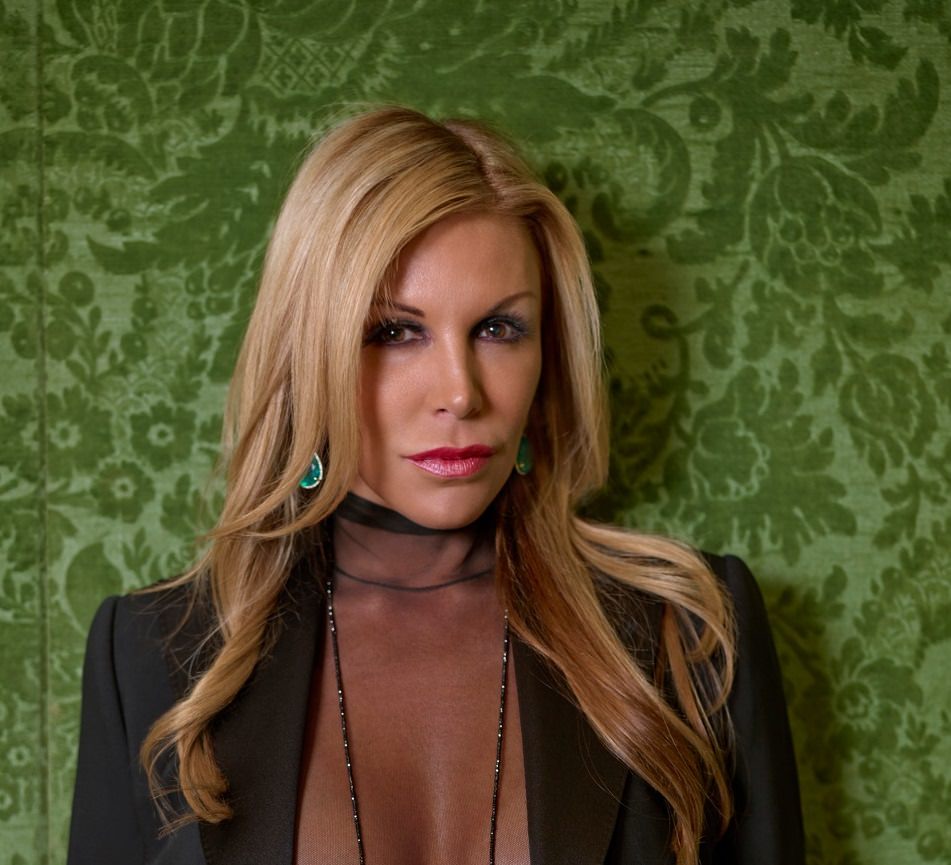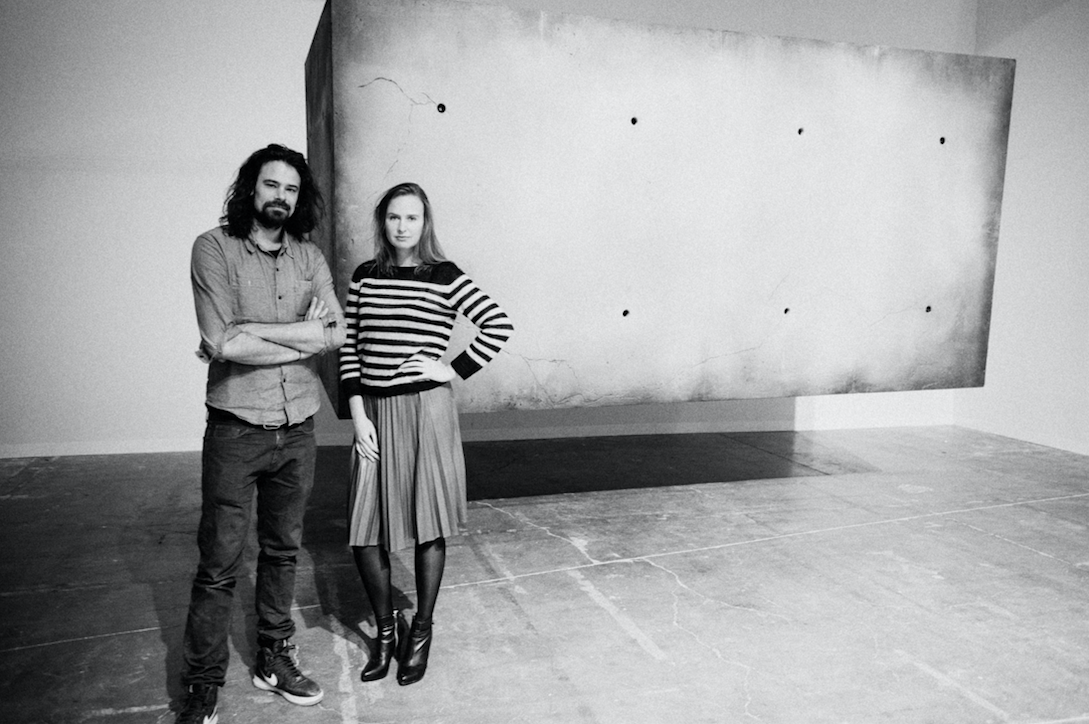Open through April 18 at Arsenal Contemporary is Canadian artist Nicolas Baier’s “Nervure’s Path.” This is Baier’s first solo exhibition in the United States, continuing his work with exploring technology’s evolution and its influence on human life. Featuring both existing and new work, the show, curated between the artist and Muriel Quancard, is anchored by a striking sculptural installation—Vanitas (Artist Desk) (2012). Visible through the gallery’s large front window, the piece is made of a glass chamber that holds a desk, an office chair, a computer with two monitors, speakers, and a scanner. All of the items enclosed are cast in mirrored nickel. And while the installation is made of glass and mirrors, and is lit by fluorescent lights, there is no room for reflection. Also on view are works on canvas, sculptural works, and Baier’s first video—made up of data farm imagery to explore the ideas of transmission of knowledge.
Whitewall spoke with the artist about his current show, about where his art journey began, and where he likes to see art when he’s back home in Montreal.
WHITEWALL: Tell us a bit about your exhibition “Nervure’s Path” at Arsenal Contemporary.
NICOLAS BAIER: The layers which make up our perception of the world—our vision, our sense of smell, our hearing—are limited and far from being efficient. The five senses only describe a fraction of existence. The capacity within these senses is also limited. Perfect vision is only perfect within the human boundaries. If we compare the totality of our capabilities to other species of the world, we can see examples of these limitations. We do not have a sonar (as bats do), an electromagnetic sense (inherent to sharks), or tetra chromatic vision (like several species of birds possess). Our brain is centralized, unlike the nine neural “brain” structures of the octopus. Scientific studies and tools (i.e. technology) allow us to discover and walk through these alternate doors of perception. They allow us to see and understand reality in a much more complex way. Our senses constantly lie to us, and today, we rely more and more on our tools to perceive the world and move within it efficiently.
WW: Tell us a bit about your view on these “tools,” like technology. What is the relationship between machine and human?
NB: Tools precede humans. Long before our initial evolutionary appearance several species “created” and utilized what we would call ‘elementary’ tools. And someday tools might bury humans by rendering us obsolete.
Up until now, our relationship with the tool has been mostly mutual—a sort of co-evolutionary story, with the computer as our external “sounding board.” Most of us see machines as external entities but I would argue they are constitutive of humans. What could be more human than a machine? Every activity, action and decision, from our first wail until our last breath, is closely linked to machines. Biologically, we have not evolved much over the past 100,000 years—save some fine tuning, for example the brain is 3 percent smaller—while metamorphoses, transformations, and the reparations and improvements of our many tools exist now on an exponential and irrepressible curve. Some refer to this as the path to the Singularity.
Most likely the tool will no longer need the human to “replicate” or improve upon itself. In the near future this will happen more and more on its own, from within and by the direction of the tools (or machines) themselves. This is radical. From an evolutionary perspective we will be the first species to create a new entity which operates in total autonomy, one that will be more and more able to adapt itself to the universe in ways that far surpass our own abilities.
The pieces included in “Nervure’s Path” speak to this fundamental relationship between the humanity and tools (mainly including the language and its new vehicle, the computer).
WW: Tell us a bit about Vanitas. What was the starting point?
NB: The starting point was a project of producing three human scale sculptures representing the offices of three different but inherently related professional paths—the artist, the astrophysicist, and the philosopher. The correlation factor was the idea that all three professions can firmly be against auto-centrism—a somewhat narcissistic axiom which places humans at the center of existence. Albeit to varying degrees, they all require a computer.
This sculpture, the artist’s office, offers a three-dimensional still life—a screenshot marking the arrival of an (increasingly) immaterial epoch. It includes distinct elements: a table, a chair, a computer, a scanner, etc. The glass cubicle, in this short-circuit proposition, accentuates the impression of anonymity. It’s a sealed micro-world, which uses the mirror to both seal itself in and open itself up. It is intimate and anonymous, highly visible and vulnerable. It’s exposed and insulates. The mirror, of course, is symbolic of self-discovery, humanity’s reflexive identity and the reflections of the world, but it is also a great engine to distort reality and access “the other.” It is from this allegorical place we begin to analyze media, production and tools for storage and the transmission of our cumulative information and knowledge. It is an intellectual, technical or artistic space work to represent it all. In a way, this work wants to expose what thinking means.
WW: Why did you specifically want there to be no reflection with this large work?
NB: The reflection is supposed to operate only inside the box, like an endless or ongoing short-circuit. The viewers, thanks to the spy glasses, are “vampirized” as their own figures are not being reflected by the mirrored objects that are inside the container.
It intends to exclude the gazer from the proposition: to separate the two worlds. I want the viewers to bear witness to a separate field—a closed scene, shut-in on itself, and so I needed to create a space of only mirrored objects that only reflect other mirrored objects, as a tentative to create an infinite reflection exercise. Only the gaze can penetrate this capsule, and once inside, it can’t really escape, as it bounces and ricochets on every single surface, anywhere but back onto the viewer, him or herself.
WW: In the exhibition, you’re also presenting your first video work. It uses data farm imagery to explore ideas around the transmission of knowledge. Why was this something you wanted to focus on?
NB: I wanted to focus on the inherence of nature and data processing. While we understand more and more that matter is made out of information, maybe there is no more difference between a thing and its referent. If nature is understood as a synonym of the Universe, or cosmos, i.e. inclusive of everything, then obviously that must also involve and include informatics, computer science and the tools that come from those pursuits.
This video is a montage—a parallel edit—which oscillates between two front-facing, slow tracking shots: one in a corridor of large server farm and the other in corridor of the forest. It’s more like a pendulum than a harsh juxtaposition. The soundtrack is also simplistic: the symbolically “unnatural” sounds of things like hard drives and the various sounds machines make poured over images of the symbolically ‘natural world,’ which here are forests (which are themselves vast networks rooted in communication and data storage). Inversely, various sounds traditionally symbolic of ‘nature’ like wind, streams and storms are poured over the symbolically “unnatural” images of servers. Everything is interchangeable. And there’s always a little sonic overflow—and that’s why I have them overlapping a bit too.
The server images and the machine soundtrack are all fabricated, that is, they are drawn and worked, created. Once the 3-D drawings were completed, we had to rent the services of a “Render Farm” to be able to “render” the tracking shots themselves. This tautology (the server farm that draws the server farm) also serves my purpose.
WW: What was your very first work?
NB: I began my art career as a photographer. I was interested in deconstructing perception, mostly using time as a trace generator. So, basically, I became a Photoshop addict, at times using way too many layers of photos to build some images.
WW: How has your practice evolved since then?
NB: I am trying to open my palette, so to speak. Adapting the medium, the technique, and the tools to the idea. My atelier is now like an old general store, where one can find all kinds of devices, pieces of equipment, machinery, or hardware.
WW: Are there any new ideas you’re aiming to explore in upcoming works?
NB: I really want to go further in exploring the relation between language (tools) and computer (as an entity).
WW: Tell us a bit about where you like to see art in Montreal.
NB: Montreal has an on-growing visual art scene. There is, of course, all the known and respected art museums, but I am concerned and maybe even pessimistic about their endless quest for entries and the already small windows of diffusion that they are really offering to visual art.
Happily, we have a swarming group of galleries and art centers of high quality, like Arsenal Montreal, Galerie Division, Galerie Hugues Charbonneau Gallery, Galerie Nicolas Robert, Pierre François Ouellet Art Contemporain, Galerie Antoine Ertaskiran, Parisian Laundry, and all the artist centers in the Pôle de Gaspé, Centre Phi, and DHC Art. There is also a lot of new pop-up galleries operated by young artists, working like those self-directed artist centers were 30 years ago, before being totally publicly financed.












